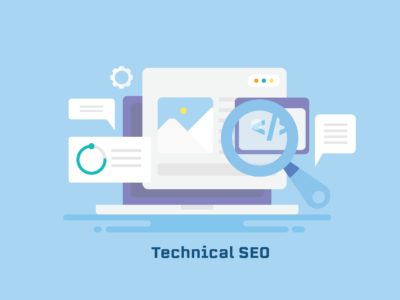This post is Stage 5 in our complete guide to search engine optimization.
Click here for the Full SEO Guide.
After you’ve finished optimizing all the pages on your site, the next step you need to work on is your off-page SEO tactics. This stage focuses on boosting your site’s ranking and search visibility.
Both on-page and off-page tactics support each other to improve your website performance and overall SEO campaign. There are a few key areas that you should focus on when building your off-page techniques, but the heart of this stage focuses a lot on backlinks.
Here are the different ranking factors for off-page SEO and the best practices for each.
Off-Page SEO Ranking Factors
-
Volume of backlinks
If a lot of websites link to your page, Google will take it as an indicator that you’re a credible source in your industry.
There are tools online to help you check the current number of backlinks you have. In this case, we’ll use Ahrefs. Simply type the domain name on Site Explorer, and it will reveal the backlink count on the overview page.
For this example, hotels.com has 77 million backlinks and over 63,200 referring domains—this strengthens their reputation and puts them as one of the top choice websites to visit in their industry.
Guest blogging is a tried and tested strategy to increase your backlinks. You can offer your content to sites that you believe will benefit from it in exchange for a valuable linkback to your website. Your goal here is to get highly-ranked websites to point to your website, so make sure you also check the domain authority (DA) of the blog you’re planning to approach.
The DA is a scale from 1-100 that shows you how credible a website is. The more high-quality backlinks you get, the higher your website’s DA will get and the easier it will be for you to rank on search engines. It’s also called Domain Rate (DR) in other tools. On Ahrefs, it appears beside the site’s number of backlinks. In the image above, you’ll see that hotels.com has a DR of 89.
*Keep in mind that different tools calculate domain authority differently, so when you’re making a comparison, make sure you’re judging them on the same platform.
If you need ideas on which sites you can approach for link building opportunities, a good tip is to spy on competitor backlinks. That way, you can directly compete with your industry rivals, and develop tactics on how to outperform them.
-
Relevance of linking domain/page
Apart from link quality, you should also consider link relevance in your strategy. There are a few factors to consider here:
-
Domain to domain relevance – Meaning the “site” linking to you is relevant to your website. You could be operating in the same industry or be producing similar types of content.
-
Domain to page relevance – Meaning the “page” linking to your website is relevant. For example, getting a backlink from a travel blog article to your hotel booking site would be highly-relevant, whereas getting a backlink from a page about online gambling wouldn’t.
-
Page to page relevance – Whether the linking page is relevant to the page that it’s being linked to.
-
Link to page relevance – Whether the link makes contextual sense on the page itself. A relevant link would add context and value to the content around it, whereas spammy, keyword-stuffed links don’t and therefore don’t pass on as much relevant authority.
Ideally, you’d want to generate backlinks to your website that are as relevant as possible. The more relevant the context is, the more search engines recognize the connection and pass authority on accordingly.
-
Anchor Text
The anchor text is also a crucial factor in your off-page SEO efforts. It should have strong relevance to the page it links to, and it should contain your website’s keywords for a stronger effect.
For instance, you could have a page that talks about a travel checklist. It’s better to link your website using relevant keywords such as “ultimate travel checklist,” or “travel packing list” instead of something generic like “click here.”
Remember, don’t make all your anchor text with the same set of keywords. If all your backlinks have the same anchor text, Google can flag your website as malicious or spammy content. Use a variety of relevant keywords to change things up and keep it natural.
-
Social Sharing
This factor became a recent addition to the ranking factors after social media changed the way we consume content online. Platforms such as Facebook, Twitter, and even Pinterest have become sources of great content for their users.
The logic behind this is the more your content gets shared and blasted online, the more people get to view and read it. If they like what they see, and they find it credible, the sharing continues. This could create opportunities for other websites to learn about your site and link to you in a future post. There’s no doubt that social media shares help increase your brand awareness.
There may not be any “direct” correlations between social shares and search rankings, but they can certainly influence factors like exposure levels that help drive ranking signals. This is why it’s important to share your site content regularly on your social media accounts and encourage social engagement.
-
High-quality content
This may seem obvious, but great content is valuable for both on-page and off-page SEO tactics. Consistently creating shareable and relevant content will naturally incline other websites to use your website as a reference or share your article. To reiterate from our on-page SEO tips, here’s what you should do to create high-quality content:
-
Write long-form pieces of about 2,000 words to demonstrate industry knowledge.
-
Use high-resolution and relevant images that convey your thoughts accurately.
-
Aim to put an original spin on your article and don’t just talk about something that’s already been said before.
-
Include statistics or studies that help illustrate and prove your claims.
Final Thoughts
By being aware of the relevancy factors and best practices above, you’re giving your website a fair chance to battle the highest ranks on the web. This will take some time and constant monitoring since Google algorithms tend to change, so it’s important to be flexible and agile in this step.
It’s better to stick to modern white-hat link building methods to rank higher and avoid any penalizations from Google. With your on-page and off-page SEO working well together, you’ll be sure to see a significant boost in performance and traffic of your website.
On the next and final installment of our SEO guide series, we’ll be discussing analyzing and tracking data. One final step to go and you’re ready to become an SEO expert. Stay tuned!






